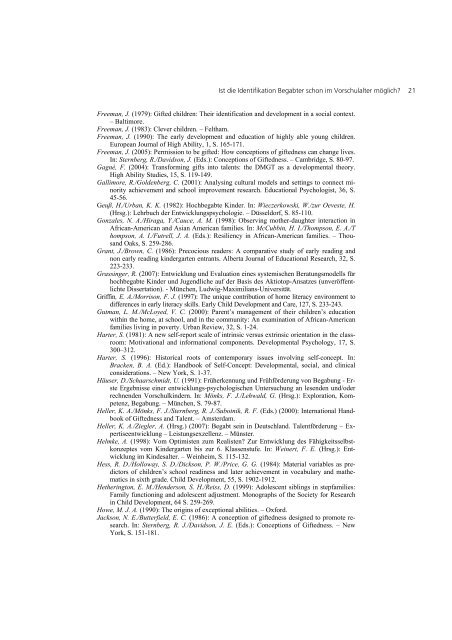Ist die Identifikation Begabter schon im Vorschulalter möglich? Ein ...
Ist die Identifikation Begabter schon im Vorschulalter möglich? Ein ...
Ist die Identifikation Begabter schon im Vorschulalter möglich? Ein ...
Sie wollen auch ein ePaper? Erhöhen Sie die Reichweite Ihrer Titel.
YUMPU macht aus Druck-PDFs automatisch weboptimierte ePaper, die Google liebt.
<strong>Ist</strong> <strong>die</strong> <strong>Identifikation</strong> <strong>Begabter</strong> <strong>schon</strong> <strong>im</strong> <strong>Vorschulalter</strong> <strong>möglich</strong>? 21<br />
Freeman, J. (1979): Gifted children: Their identification and development in a social context.<br />
– Balt<strong>im</strong>ore.<br />
Freeman, J. (1983): Clever children. – Feltham.<br />
Freeman, J. (1990): The early development and education of highly able young children.<br />
European Journal of High Ability, 1, S. 165-171.<br />
Freeman, J. (2005): Permission to be gifted: How conceptions of giftedness can change lives.<br />
In: Sternberg, R./Davidson, J. (Eds.): Conceptions of Giftedness. – Cambridge, S. 80-97.<br />
Gagné, F. (2004): Transforming gifts into talents: the DMGT as a developmental theory.<br />
High Ability Stu<strong>die</strong>s, 15, S. 119-149.<br />
Gall<strong>im</strong>ore, R./Goldenberg, C. (2001): Analysing cultural models and settings to connect minority<br />
achievement and school <strong>im</strong>provement research. Educational Psychologist, 36, S.<br />
45-56.<br />
Geuß, H./Urban, K. K. (1982): Hochbegabte Kinder. In: Wieczerkowski, W./zur Oeveste, H.<br />
(Hrsg.): Lehrbuch der Entwicklungspsychologie. – Düsseldorf, S. 85-110.<br />
Gonzales, N. A./Hiraga, Y./Cauce, A. M. (1998): Observing mother-daughter interaction in<br />
African-American and Asian American families. In: McCubbin, H. I./Thompson, E. A./T<br />
hompson, A. I./Futrell, J. A. (Eds.): Resiliency in African-American families. – Thousand<br />
Oaks, S. 259-286.<br />
Grant, J./Brown, C. (1986): Precocious readers: A comparative study of early reading and<br />
non early reading kindergarten entrants. Alberta Journal of Educational Research, 32, S.<br />
223-233.<br />
Grassinger, R. (2007): Entwicklung und Evaluation eines systemischen Beratungsmodells für<br />
hochbegabte Kinder und Jugendliche auf der Basis des Aktiotop-Ansatzes (unveröffentlichte<br />
Dissertation). - München, Ludwig-Max<strong>im</strong>ilians-Universität.<br />
Griffin, E. A./Morrison, F. J. (1997): The unique contribution of home literacy environment to<br />
differences in early literacy skills. Early Child Development and Care, 127, S. 233-243.<br />
Gutman, L. M./McLoyed, V. C. (2000): Parent’s management of their children’s education<br />
within the home, at school, and in the community: An examination of African-American<br />
families living in poverty. Urban Review, 32, S. 1-24.<br />
Harter, S. (1981): A new self-report scale of intrinsic versus extrinsic orientation in the classroom:<br />
Motivational and informational components. Developmental Psychology, 17, S.<br />
300–312.<br />
Harter, S. (1996): Historical roots of contemporary issues involving self-concept. In:<br />
Bracken, B. A. (Ed.): Handbook of Self-Concept: Developmental, social, and clinical<br />
considerations. – New York, S. 1-37.<br />
Häuser, D./Schaarschmidt, U. (1991): Früherkennung und Frühförderung von Begabung - Erste<br />
Ergebnisse einer entwicklungs-psychologischen Untersuchung an lesenden und/oder<br />
rechnenden Vorschulkindern. In: Mönks, F. J./Lehwald, G. (Hrsg.): Exploration, Kompetenz,<br />
Begabung. – München, S. 79-87.<br />
Heller, K. A./Mönks, F. J./Sternberg, R. J./Subotnik, R. F. (Eds.) (2000): International Handbook<br />
of Giftedness and Talent. – Amsterdam.<br />
Heller, K. A./Ziegler, A. (Hrsg.) (2007): Begabt sein in Deutschland. Talentförderung – Expertiseentwicklung<br />
– Leistungsexzellenz. – Münster.<br />
Helmke, A. (1998): Vom Opt<strong>im</strong>isten zum Realisten? Zur Entwicklung des Fähigkeitsselbstkonzeptes<br />
vom Kindergarten bis zur 6. Klassenstufe. In: Weinert, F. E. (Hrsg.): Entwicklung<br />
<strong>im</strong> Kindesalter. – Weinhe<strong>im</strong>, S. 115-132.<br />
Hess, R. D./Holloway, S. D./Dickson, P. W./Price, G. G. (1984): Material variables as predictors<br />
of children’s school readiness and later achievement in vocabulary and mathematics<br />
in sixth grade. Child Development, 55, S. 1902-1912.<br />
Hetherington, E. M./Henderson, S. H./Reiss, D. (1999): Adolescent siblings in stepfamilies:<br />
Family functioning and adolescent adjustment. Monographs of the Society for Research<br />
in Child Development, 64 S. 259-269.<br />
Howe, M. J. A. (1990): The origins of exceptional abilities. – Oxford.<br />
Jackson, N. E./Butterfield, E. C. (1986): A conception of giftedness designed to promote research.<br />
In: Sternberg, R. J./Davidson, J. E. (Eds.): Conceptions of Giftedness. – New<br />
York, S. 151-181.


